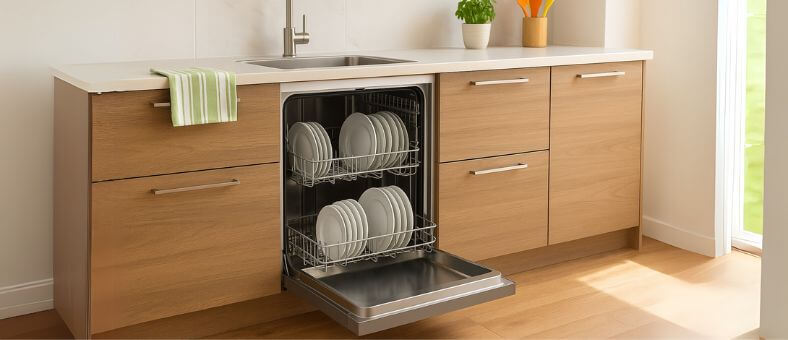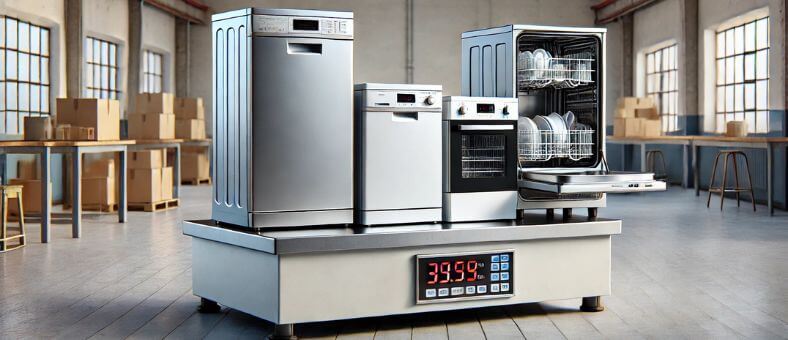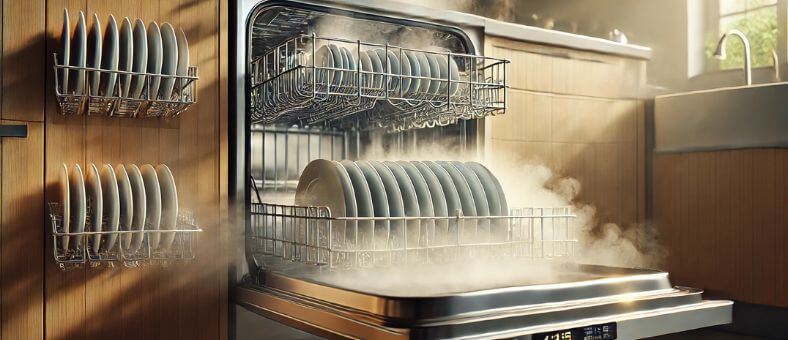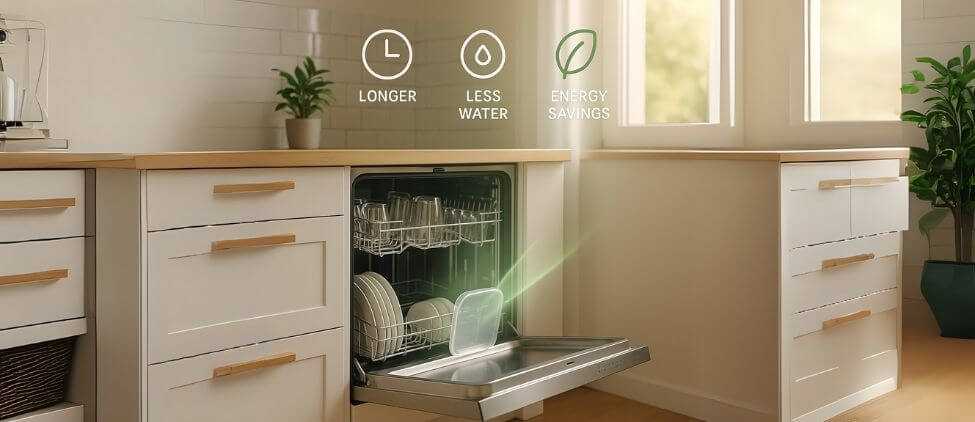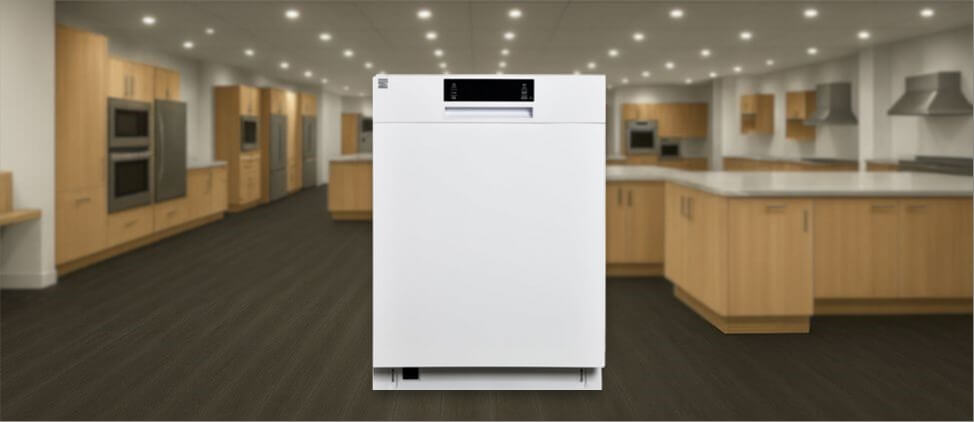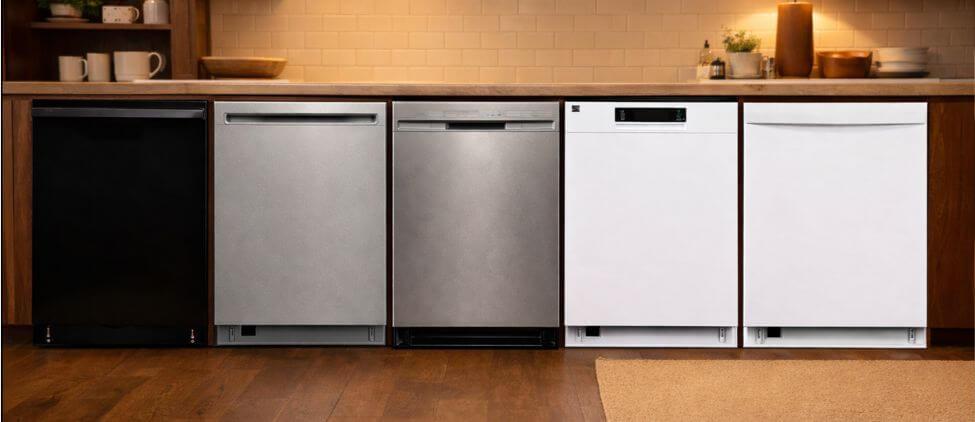Ever looked at your kitchen and thought, “There’s got to be a better way to handle these dishes?” We all love eating, but the pile of dirty dishes afterward? Not so much. If you’re tired of that mess and want a clean kitchen without dishes taking over, you might need a built-in dishwasher. Now, you must be wondering, What is a built-in dishwasher? Don’t worry; we will cover all the information.
Imagine a machine tucked away neatly under your counter. It’s not in your way, and it’s ready to clean your dishes while you relax. That’s a built-in dishwasher! These are like magic boxes: you put in dirty dishes, close the door, and boom! After a while, they come out clean. And the best part? They fit so nicely in your kitchen that you might forget they’re even there.
Now, if you’re thinking about making your life easier and your kitchen prettier, stick around. We’ll dive deep into everything you need to know about built-in dishwashers. By the end of this, you might just want one for yourself! Let’s jump in and learn together.
Dishwasher Popularity
DDid you know that over 75% of American homes use a dishwasher, with built-ins being the top choice!
Table of Contents
How Does a Built-In Dishwasher Work?
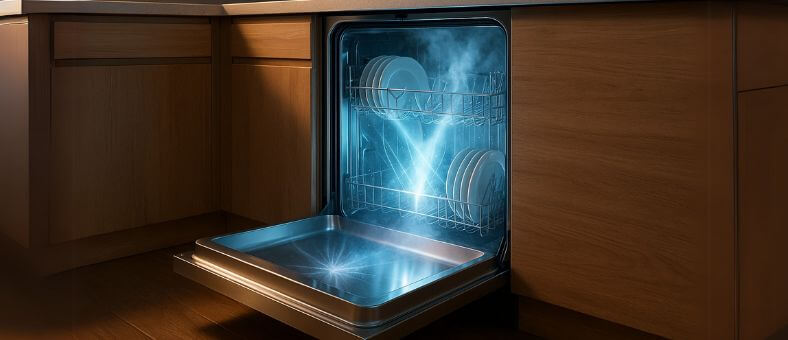
A built-in dishwasher operates through a series of steps designed to provide efficient and thorough cleaning of your dishes. Here’s a simplified explanation of how it works:
- Load the Dishes: Place dishes, glasses, and cutlery in the racks, avoiding overcrowding and keeping spray arms unblocked.
- Add Detergent: Fill the detergent dispenser with the recommended amount of dishwasher detergent.
- Select a Wash Cycle: Based on how dirty your dishes are, choose a cleaning cycle. Options typically include normal, heavy, quick wash, or eco modes.
- Water Inflow Begins: The dishwasher draws water from your home’s supply and fills the base appropriately.
- Water is Heated: The built-in heater raises the temperature (usually 140–160°F or 60–71°C) for effective cleaning and sanitation.
- Spray Arms Activate: Rotating spray arms blast the hot, soapy water onto dishes to loosen and remove food particles.
- Dirty Water is Drained: After the wash phase, the dirty water is pumped out of the machine.
- Rinse Cycle Starts: Fresh hot water is sprayed to remove detergent residue and remaining grime.
- Drying Phase: Depending on the model, heated air or rinse helps evaporate leftover moisture. Some units may rely on natural air drying.
- Cycle Ends: The dishwasher signals completion—your dishes are now clean, dry, and ready to be unloaded.
Top Picks
Looking for a built-in dishwasher that blends seamlessly into your kitchen? Here are a few top-rated options to consider:
- Midea MDF18A1AST Built-in Dishwasher
Ideal for smaller kitchens, this dishwasher offers 8 place settings and six wash programs, all within a compact 18-inch frame. - ZLINE 24″ Top Control Built-In Dishwasher
Features a sleek stainless steel exterior and a quiet 52dBa operation, combining aesthetics with performance. - Kenmore 24″ Built-In Stainless Steel Tub Dishwasher
Equipped with SmartWash technology and adjustable racks, this model adapts to your dishwashing needs efficiently.
Famous Era of Built-in Dishwashers
Did you know that Built-in dishwashers became popular in the 1960s, transforming modern kitchen designs?
Exploring the Benefits: Why Should You Consider a Built-In Dishwasher?

Built-in dishwashers aren’t just appliances but functional design upgrades that enhance your kitchen’s performance, convenience, and style. Here’s why making the switch could be a smart move for your home:
- Seamless Integration: Designed to fit flush with your kitchen cabinetry, built-in dishwashers create a clean, unified look—perfect for modern and open-plan kitchens.
- Larger Capacity: Most built-in models offer more space for dishes, making them ideal for families or those who entertain frequently.
- Fewer Loads, More Efficiency: Greater capacity means fewer wash cycles are needed, saving time, water, and energy in the long run.
- Quieter Operation: Built-in dishwashers are generally better insulated than portable ones, resulting in whisper-quiet performance—great for evening use or open living spaces.
- Advanced Features: Many models come equipped with smart sensors, adjustable racks, soil detection, and energy-efficient wash cycles for optimal performance.
- Improved Property Value: A sleek, built-in appliance can increase the appeal and value of your kitchen during resale or renovation.
- Hands-Free Convenience: Permanently plumbed in and always ready to use—no need to move or hook up each time like portable models.
- Safety and Stability: Securely fixed into place, there’s no risk of tipping, shifting, or accidental water spillage during use.
If these benefits align with your lifestyle and kitchen needs, consider these highly-rated built-in dishwashers that offer exceptional performance, sleek design, and long-term reliability:
Recommended Dishwashers:
- Honeywell 18-Inch Built-In Dishwasher
Perfect for tight spaces, offering 8 place settings and a stainless steel tub in an 18-inch design. - EdgeStar BIDW1802SS 18-Inch Built-In Dishwasher
A cost-effective choice without compromising on essential features, suitable for small households. - BLACK+DECKER 24″ Built-In Dishwasher, Designer Series
Designed for minimal noise, this dishwasher provides a peaceful kitchen environment while delivering effective cleaning.
Built-in Dishwasher is Not just for Dishes
Did you know that some people use built-in dishwashers to sanitize toys and even wash baseball caps?
Built-In Dishwashers: A Balanced View of Their Strengths and Weaknesses
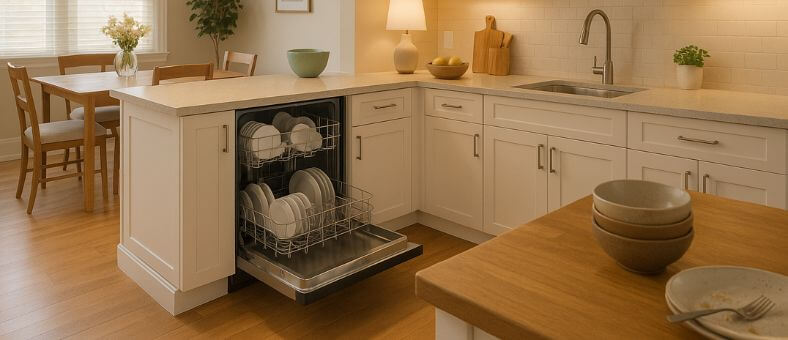
Every appliance has its own benefits and drawbacks, and built-in dishwashers are no exception. Let’s delve into the primary positives and negatives to keep in mind.
Pros and Cons of a Built-In Dishwasher
| Pros | Cons |
|---|---|
| Blends perfectly with kitchen cabinets, giving your kitchen a sleek, modern appearance. | Requires dedicated space and plumbing setup, which often needs professional installation. |
| Offers more room for dishes, making it ideal for large families or frequent entertainers. | Once installed, it’s difficult to move, limiting layout flexibility. |
| Packed with modern features like multiple wash cycles, delay start, and energy-saving options. | Generally comes with a higher price tag, both for the appliance and installation. |
| Operates quietly thanks to better insulation, making it less disruptive in open living spaces. | May not be suitable for small kitchens or homes with limited cabinet space. |
| Securely installed, so there’s no need to move or stabilize it during use. | Integrated design can make repairs or replacements more time-consuming and costly. |
If the pros align with your needs, check out these customer-favorite built-in dishwashers that offer great value:
Recommended Models:
- Forno 24″ Inch. Built-In Dishwasher
- Spacious, smart, and stylish with 6 wash cycles, 14 place settings, and a stainless steel interior.
- Bosch SHX78CM5N 800 Series 24″ Built-In Dishwasher
- Ultra-quiet (42 dB), smart-enabled, and features CrystalDry™ and PrecisionWash® for spotless, efficient cleaning.s.
- SHARP 24″ Slide-In Dishwasher
- Features soil sensors, premium white LED interior lighting, smooth glide rails, and a heated dry option for efficient, quiet cleaning.
Key Factors to Consider When Selecting a Built-In Dishwasher
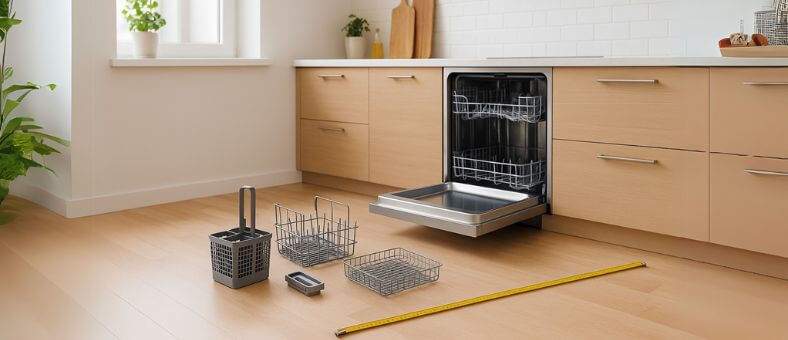
Choosing a built-in dishwasher requires consideration of several factors to ensure it meets your needs, fits seamlessly into your kitchen, and provides the best value for your investment. Here are some critical steps to guide your decision-making process:
- Measure Your Space: Measure your designated dishwasher area’s height, width, and depth. Leave room for the door to open fully and for proper ventilation.
- Assess Your Needs: Think about your dishwashing habits. Large households or frequent entertainers may need a higher-capacity model with flexible racking systems.
- Consider Energy Efficiency: Look for ENERGY STAR® certified dishwashers to reduce utility bills and minimize environmental impact.
- Evaluate Noise Level: For open-concept or nighttime use, choose a model with a noise level below 50 dB for quiet operation.
- Check Available Wash Cycles: Choose a dishwasher with cycles that match your lifestyle—quick wash, heavy-duty, eco, sanitize, or sensor-based auto cycles.
- Understand the Cost: Balance your budget with long-term value. Installation fees should be included when evaluating the total cost.
- Read Reviews and Ratings: See what real users say about performance, reliability, and ease of use to avoid common pitfalls.
- Warranty and Customer Support: Choose brands with strong warranties and proven customer service for peace of mind.
If you’re looking for a reliable built-in dishwasher with great features and performance, here are some top-rated models worth exploring for your kitchen upgrade.
Top Built-In Dishwashers to Consider:
- COSMO COS-DWD24FBR
Tall tub design with front controls and a fingerprint-resistant stainless steel finish—built for convenience and modern style. - West Bend 18″ Built-In Dishwasher
Compact and quiet with 6 automatic cycles, 3 wash options, and a sleek stainless steel build—perfect for smaller kitchens. - Kenmore Elite 24″ Built-In Dishwasher
Feature-packed with SmartWash, UltraWash Plus, TurboDry, and a TotalFlex 3rd rack—efficient, spacious, and Energy Star certified.
Efficient in Killing Bacteria
Built-in dishwashers can kill 99% of bacteria in dishes, making them healthier than hand-washing.
Remember, the best built-in dishwasher for you depends on your needs, kitchen layout, and budget. Take the time to research and compare different models before making your decision.
How Do the Various Types of Built-in Dishwashers Differ?
Built-in dishwashers, while sharing the characteristic of being installed into a kitchen’s cabinetry, can differ significantly based on a few key aspects. The standard 24-inch dishwasher is the most common type. It offers the highest capacity, making it suitable for larger households.
On the other hand, compact 18-inch dishwashers are designed to fit in smaller kitchens without sacrificing functionality. In addition, drawer dishwashers, available as single or double-drawer units, provide flexibility in washing loads of different sizes separately. Lastly, fully integrated dishwashers feature a concealed control panel for a seamless look. At the same time, semi-integrated models display only the control buttons. The differences in size, design, and functionality among these types cater to various needs and preferences, ensuring a suitable built-in dishwasher for every kitchen.
Are All Built-in Dishwashers the Same Size?
Residential dishwashers that come pre-installed in homes are available in two sizes – 18 inches (approximately 46 cm) and 24 inches (approximately 60 cm). Therefore, it is essential to consider the following factors to determine which size is best suited for your kitchen:
For smaller households or kitchens that utilize the dishwasher sparingly, a width of 18 inches is recommended. On the other hand, a width of 24 inches is typically more suitable for larger households, especially those that use their dishwasher more frequently.
You can select the dishwasher size that best fits your lifestyle and kitchen requirements by evaluating your lifestyle and kitchen requirements.
What is the Difference Between a Built-In and a Portable Dishwasher?
A built-in and a portable dishwasher differ primarily in their installation, size, capacity, and functionality.
| Built-In Dishwasher | Portable Dishwasher |
|---|---|
| Installed directly into kitchen cabinetry for a seamless, permanent look. | Freestanding and can be rolled away or stored when not in use. |
| Requires a fixed water line and permanent plumbing connection. | Connects to the kitchen faucet and drains into the sink—no permanent plumbing needed. |
| Generally larger with higher capacity, ideal for bigger households or frequent use. | Smaller in size and capacity, better suited for singles, couples, or occasional use. |
| Offers advanced features such as multiple cycles, soil sensors, and energy-saving modes. | Simpler features but convenient for basic dishwashing needs. |
| Installation is more complex and often requires professional assistance. | Easy to set up without the need for a technician or renovation work. |
Still deciding between a built-in and a portable dishwasher? Here are top-rated options from both categories to help you compare real-world performance, convenience, and value:
Built-In Dishwasher Recommendations:
- SPT SD-6502W 24″ Built-In Dishwasher
Features a Smart Wash System, heated drying, and a stainless steel tall tub—ideal for efficient, high-capacity cleaning. - GE Profile PDT755SYVFS 24″ Built-In Smart Dishwasher
Whisper-quiet at 42 dBA, this model features a Deep Clean 3rd Rack, Microban®
Portable Dishwasher Recommendations:
- BLACK+DECKER 18″ Portable Dishwasher
Compact and mobile with 8-place settings, 6 wash programs, stainless steel tub, and a convenient faucet connection—ideal for small kitchens and apartments. - Farberware FDW05ASBWHA Portable Countertop Dishwasher
Compact and versatile with a 5-liter built-in water tank, 5 wash programs including Baby Care and Fruit Wash, and a sleek black/white design—ideal for small kitchens, RVs, and dorms.
Final Thoughts on What is a Built-in Dishwasher
We’ve just sailed through the fantastic world of built-in dishwashers, those magical machines that tuck away neatly in our kitchens. They’re like superheroes, fighting dirty dishes and giving us sparkly clean ones in return! Built-in dishwashers are transforming our kitchens into sleek, stylish spaces. They’re not just dish cleaners; some even help sanitize toys and hats.
Now, if you’re dreaming of a cleaner kitchen without those pesky piled-up dishes, it’s time to make that dream come true. Remember, with a built-in dishwasher, you’re not just buying a machine; you’re buying peace of mind, efficiency, and extra free time! So, why wait? Dive into the world of easy, efficient cleaning and give your kitchen the superstar it deserves!
If you’re still exploring options, here are a few more top-rated built-in dishwashers that combine efficiency, design, and performance:
- Midea MDF18A1AWW 18″ Built-In Dishwasher
Compact and quiet (52 dBA), this ENERGY STAR-certified model offers 8 place settings, 6 wash cycles, and a stainless steel tub—ideal for small kitchens. - Avanti DWT18V3S 18″ Built-In Dishwasher
Space-saving design with 8 place settings, 6 automatic cycles, and a low noise rating of 53 dBA. Features include a top control LED display and stainless steel construction. - Summit DW2435SSADA 24″ ADA Compliant Built-In Dishwasher
Designed for accessibility, this ENERGY STAR-certified dishwasher accommodates 12 place settings, operates at a quiet 49 dBA, and features digital touch controls with 5 wash cycles.
At WashDryDazzle, we’re dedicated to providing essential insights that make your daily chores effortless. Dive deeper into our comprehensive Dishwasher Education hub to learn more.
Frequently Asked Questions (FAQs)
What is smart technology in a built-in dishwasher?
Smart technology means the dishwasher can do cool things like tell you when it’s done cleaning or if something’s wrong. Some can even be started with a phone!
Do I need a special guide to install a built-in dishwasher?
Yes, dishwashers come with an installation guide. This guide helps someone set it up in your kitchen the right way. If you’re unsure, asking a grown-up or professional for help is good.
How does the water-saving feature work in a dishwasher?
The water-saving feature means the dishwasher uses less water to clean dishes. It’s like when you turn off the tap while brushing your teeth to save water.
Why do some dishwashers have a stainless steel interior?
Stainless steel inside a dishwasher is strong and doesn’t rust. This means it lasts a long time and keeps the inside looking clean.
How does a built-in dishwasher save space on my countertop?
A built-in dishwasher goes under your kitchen counter. So, you have more space on top to do other things, like making sandwiches!
What is child-lock safety on a dishwasher?
The child-lock safety is like a special lock on the dishwasher. It keeps kids from opening it while it’s working. It’s to make sure everyone stays safe.
What is a hard food disposer in a dishwasher?
The hard food disposer breaks down and removes big food bits left on dishes. It’s like a mini garbage can inside the dishwasher.
What is the rinse-and-hold feature?
The rinse-and-hold feature lets the dishwasher splash water on dishes to keep them wet. It’s like giving them a quick shower before the full bath later.
Is using a built-in dishwasher cheaper than washing by hand?
Sometimes, yes! Dishwashers can use less water and soap than hand washing. Plus, it saves you time. So, it can be cheaper in the long run.
Which are the top brands for built-in dishwashers?
Some of the leading brands include Bosch, KitchenAid, Miele, and Samsung.
Find the Perfect Built-In Dishwasher for Your Home
Elevate your kitchen with the ideal built-in dishwasher. Our comprehensive reviews cover many built-in models, providing detailed insights into their features, efficiency, and user satisfaction. Whether you’re looking for advanced cleaning capabilities, specific design elements, or energy-efficient options, our reviews are the perfect starting point for your search.
Navigate through our expert evaluations to discover the built-in dishwasher that best suits your kitchen’s aesthetics and functional needs. Each review is crafted to help you make a well-informed decision, ensuring you choose a model that seamlessly integrates into your kitchen and enhances your daily routine.
Explore Built-In Dishwasher Reviews
Find the Perfect Portable Dishwasher for Your Home
Upgrade your dishwashing experience with the ideal portable dishwasher. Our expert reviews cover a wide range of portable models, offering in-depth insights into their features, mobility, cleaning power, and user satisfaction. Whether you need a space-saving solution for a small kitchen, a renter-friendly option, or a model with excellent energy efficiency, our reviews are the perfect starting point for your search.
Browse our carefully curated evaluations to find the portable dishwasher that best fits your space, lifestyle, and cleaning needs. Each review is designed to help you make a confident, informed decision, ensuring you select a model that offers both flexibility and reliable performance wherever you use it.
Explore Portable Dishwasher Reviews

